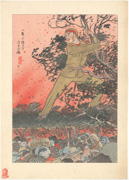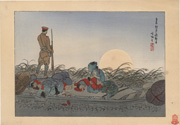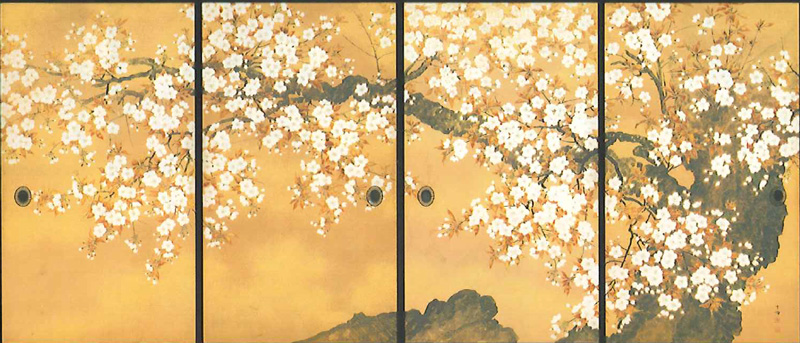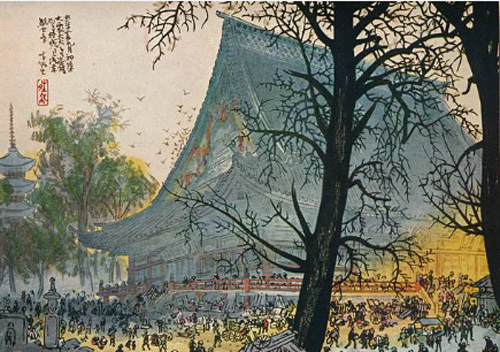Prints in Collection
IHL Cat. #1007
IHL Cat. #1301
Biographical Data
Biography
Fukunaga Seihan 福永晴帆 (1884-1961)
Sources: Independent Administrative Institution National Institutes for Cultural Heritage Tokyo National Research Institute for Cultural Heritage https://www.tobunken.go.jp/materials/bukko/9061.html; Kakedo Japanese Art Gallery http://kagedo.com/wordpress/g/page/11/; SATEeee website https://hanging-scroll-kaitori.com/fukunagaseihan/ and as footnoted. 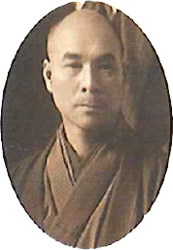 Fukunaga Seihan 福永晴帆 image source: City of Munakata | Fukunaga Seihan was born on May 15, 1881 in Asa-gun, Yamaguchi Prefecture. He studied Chinese poetry and classics under Takatori Gakuyō 鷹取岳陽 (1882-1917), which would later inform his kacho-e (bird and flower paintings) and nanga (literati painting). At the age of 16 he moved to Kyoto to study painting under Mori Kansai 森寛斎 (1814-1894), a Maruyama school painter, and he also studied with the landscape and kacho-e artist Oba Gakusen 大庭学僊 (1820-1889). In 1908, he accompanied statesman and former Prime Minister Itō Hirobumi (1841-1909) on a tour of Korea, Peking and Shanghai. From 1910 until 1915, Fukunaga lived in Europe, studying art in England and later travelling to France to study water color and oil painting.1 Returning to Japan in 1915, he settled in Simodani, Tokyo and was accepted as an exhibitor in the the Bunten (Ministry of Education) Exhibition (Monbusho Bijutsu Tenrankai). He would go on to show his work at the Bunten's successor the Teiten, but mainly he would exhibit in solo exhibitions in keeping with what has been called his "independent nature". In 1924 he was granted an audience at the Akasaka Imperial Palace and one of his kachō (bird and flower) paintings was purchased by the Imperial Household Agency. |
Fukunaga is most famous for his fusuma-e (sliding screen paintings), which can be found at Ninnaji Temple (Pine Tree paintings), Atsuta Shrine, Niwa temple, Munakata-Taisha shrine (see image below), and the Imperial Ise Shrines.
Cherry Blossoms 桜図, c. mid-1930s
Originally installed in Yasukuni Shinto shrine in 1964 it was moved to Munakata-Taisha shrine in 1981
image source: City of Munakata exhibition flier
 Listed in the Japanese Biographical Index as a "painter, wood-carver"2, a 1926 article in The Studio: An Illustrated Magazine of Fine and Applied Art credits Fukunaga with being a part of the "revival of wood-block printing" going on to say, "A painter of recognised standing, known for his originality in getting certain colour effects in his painting, he had designed a series of prints illustrating the great Tokyo earthquake and fire with a view to making a permanent pictorial record of a number of acts of heroism which were called forth by that awful catastrophe."3 The below print is reproduced in the magazine as an example from the referenced series titled Picture Album of the History of the Taishō Great Earthquake. (Note that the print's margins are not shown on the reproduction.) Each of the four prints (two of which are in this collection), I have seen in the series use the artist's seal reading 晴帆 (Seihan), shown left, which may be unique to this set of prints
Listed in the Japanese Biographical Index as a "painter, wood-carver"2, a 1926 article in The Studio: An Illustrated Magazine of Fine and Applied Art credits Fukunaga with being a part of the "revival of wood-block printing" going on to say, "A painter of recognised standing, known for his originality in getting certain colour effects in his painting, he had designed a series of prints illustrating the great Tokyo earthquake and fire with a view to making a permanent pictorial record of a number of acts of heroism which were called forth by that awful catastrophe."3 The below print is reproduced in the magazine as an example from the referenced series titled Picture Album of the History of the Taishō Great Earthquake. (Note that the print's margins are not shown on the reproduction.) Each of the four prints (two of which are in this collection), I have seen in the series use the artist's seal reading 晴帆 (Seihan), shown left, which may be unique to this set of printsOther than the above references, I have found no other information about his involvement with designing or carving woodblocks.
Saving the Asakusa Temple from Fire (After the Great Earthquake), 1923
1 Both the Victorian School of Art in Stroud, Gloucestershire and Oxford (Oxford College or Art or Oxford University are possibilities) are mentioned as schools where he studied art while in England.
2 Japanese Biographical Index, Berend Wispelwey, De Gruyter Saur, 2004, p. 122.3 The Studio, Volume 91, Issue 397, Offices of The Studio, 1926, p. 259.
latest revision:
10/28/2020 created
